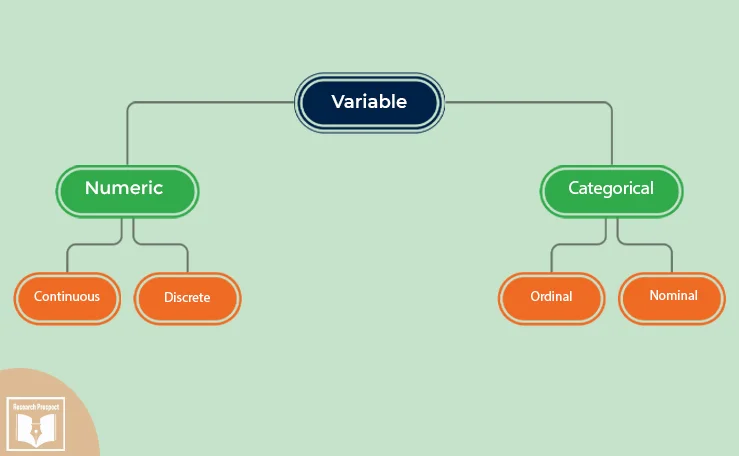Types of Variables – A Comprehensive Guide
Published by at August 14th, 2021 , Revised On October 26, 2023
A variable is any qualitative or quantitative characteristic that can change and have more than one value, such as age, height, weight, gender, etc.
Before conducting research, it’s essential to know what needs to be measured or analysed and choose a suitable statistical test to present your study’s findings.
In most cases, you can do it by identifying the key issues/variables related to your research’s main topic.
Example: If you want to test whether the hybridisation of plants harms the health of people. You can use the key variables like agricultural techniques, type of soil, environmental factors, types of pesticides used, the process of hybridisation, type of yield obtained after hybridisation, type of yield without hybridisation, etc.
Variables are broadly categorised into:
- Independent variables
- Dependent variable
- Control variable
Independent Vs. Dependent Vs. Control Variable
| Type of variable | Definition | Example | |
|---|---|---|---|
| Independent Variable (Stimulus) | It is the variable that influences other variables. |
|
|
| Dependent variable (Response) | The dependent variable is the outcome of the influence of the independent variable. | You want to identify “How refined carbohydrates affect the health of human beings?”
Independent variable: refined carbohydrates Dependent variable: the health of human beings You can manipulate the consumption of refined carbs in your human participants and measure how those levels of consuming processed carbohydrates influence human health. |
|
| Control Variables |
|
Physical activities, water consumption, natural environment of the participants. |
The research includes finding ways:
- To change the independent variables.
- To prevent the controlled variables from changing.
- To measure the dependent variables.
Note: The term dependent and independent is not applicable in correlational research as this is not a controlled experiment. A researcher doesn’t have control over the variables. The association and between two or more variables are measured. If one variable affects another one, then it’s called the predictor variable and outcome variable.
Example: Correlation between investment (predictor variable) and profit (outcome variable)
What data collection best suits your research?
- Find out by hiring an expert from ResearchProspect today!
- Despite how challenging the subject may be, we are here to help you.
Types of Variables Based on the Types of Data
A data is referred to as the information and statistics gathered for analysis of a research topic. Data is broadly divided into two categories, such as:
Quantitative/Numerical data is associated with the aspects of measurement, quantity, and extent.
Categorial data is associated with groupings.
A qualitative variable consists of qualitative data, and a quantitative variable consists of a quantitative variable.
Quantitative Variable
The quantitative variable is associated with measurement, quantity, and extent, like how many. It follows the statistical, mathematical, and computational techniques in numerical data such as percentages and statistics. The research is conducted on a large group of population.
Example: Find out the weight of students of the fifth standard studying in government schools.
The quantitative variable can be further categorised into continuous and discrete.
| Type of variable | Definition | Example |
|---|---|---|
| Continuous Variable | A continuous variable is a quantitative variable that can take a value between two specific values. |
|
| Discrete Variable | A discrete variable is a quantitative variable whose attributes are separated from each other. | Literacy rate, gender, and nationality.
Scale: Nominal and ordinal. |
Categorial Variable
The categorical variable includes measurements that vary in categories such as names but not in terms of rank or degree. It means one level of a categorical variable cannot be considered better or greater than another level.
Example: Gender, brands, colors, zip codes
The categorical variable is further categorised into three types:
| Type of variable | Definition | Example |
|---|---|---|
| Dichotomous (Binary) Variable | This is the categorical variable with two possible results (Yes/No) | Alcoholic (Yes/No) |
| Nominal Variable | Nominal Variable can take the value that is not organised in terms of groups, degree, or rank. |
|
| Ordinal Variable | Ordinal Variable can take the value that can be logically ordered or ranked. |
|
Note: Sometimes, an ordinal variable also acts as a quantitative variable. Ordinal data has an order, but the intervals between scale points may be uneven.
Example: Numbers on a rating scale represent the reviews’ rank or range from below average to above average. However, it also represents a quantitative variable showing how many stars and how much rating is given.
Not sure which statistical tests to use for your data?
Let the experts at ResearchProspect do the daunting work for you.
Using our approach, we illustrate how to collect data, sample sizes, validity, reliability, credibility, and ethics, so you won’t have to do it all by yourself!
Other Types of Variables
It’s important to understand the difference between dependent and independent variables and know whether they are quantitative or categorical to choose the appropriate statistical test.
There are many other types of variables to help you differentiate and understand them.
Also, read a comprehensive guide written about inductive and deductive reasoning.
| Type of variable | Definition | Example | |
|---|---|---|---|
| Confounding variables | The confounding variable is a hidden variable that produces an association between two unrelated variables because the hidden variable affects both of them. | There is an association between water consumption and cold drink sales.
The confounding variable could be the hot weather and compels people to drink a lot of water and a cold drink to reduce heat and thirst caused due to the heat. |
|
| Latent Variable | These are the variables that cannot be observed or measured directly. | Self-confidence and motivation cannot be measured directly. Still, they can be interpreted through other variables such as habits, achievements, perception, and lifestyle. | |
| Composite variables |
|
Survey questionnaire in which respondents were asked to indicate the purpose of using computers. They could score multiple categories, such as:
|
|
| Moderator Variable | The moderator variable affects the cause-and-effect relationship between the independent and dependent variables. As a result, the influence of the independent variable is in the presence of the moderator variable. |
Suppose you want to conduct a study, educational awareness of a specific area. Educational awareness will be your dependent variable. The area will be an independent variable if you feel that the student’s age/race may also affect the student’s association between area and educational awareness. Then age/race will be considered as the moderator variable. However, they might be more than one moderator variable, and you need to decide which one to use a moderator variable. |
Frequently Asked Questions
The 10 types of variables in research are:
- Independent
- Dependent
- Control
- Confounding
- Continuous
- Discrete
- Categorical
- Nominal
- Ordinal
- Extraneous.
An independent variable, often termed the predictor or explanatory variable, is the variable manipulated or categorized in an experiment to observe its effect on another variable, called the dependent variable. It’s the presumed cause in a cause-and-effect relationship, determining if changes in it produce changes in the observed outcome.
In research, a variable is any attribute, quantity, or characteristic that can be measured or counted. It can take on various values, making it “variable.” Variables can be classified as independent (manipulated), dependent (observed outcome), or control (kept constant). They form the foundation for hypotheses, observations, and data analysis in studies.
A dependent variable is the outcome or response being studied in an experiment or investigation. It’s what researchers measure to determine the effect of changes in the independent variable. In a cause-and-effect relationship, the dependent variable is presumed to be influenced or caused by the independent variable.
In programming, a variable is a symbolic name for a storage location that holds data or values. It allows data storage and retrieval for computational operations. Variables have types, like integer or string, determining the nature of data they can hold. They’re fundamental in manipulating and processing information in software.
A control variable in research is a factor that’s kept constant to ensure that it doesn’t influence the outcome. By controlling these variables, researchers can isolate the effects of the independent variable on the dependent variable, ensuring that other factors don’t skew the results or introduce bias into the experiment.
In science, a controlled variable is a factor that remains constant throughout an experiment. It ensures that any observed changes in the dependent variable are solely due to the independent variable, not other factors. By keeping controlled variables consistent, researchers can maintain experiment validity and accurately assess cause-and-effect relationships.
Ideally, an investigation should have one independent variable to clearly establish cause-and-effect relationships. Manipulating multiple independent variables simultaneously can complicate data interpretation.
However, in advanced research, experiments with multiple independent variables (factorial designs) are used, but they require careful planning to understand interactions between variables.













